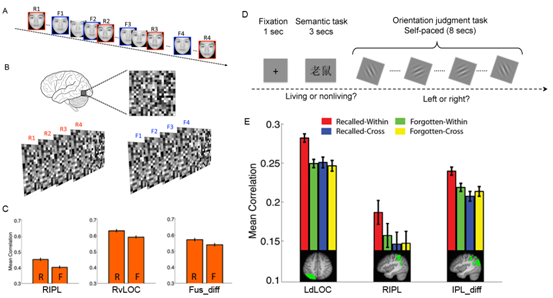The primary interest of our research is to understand the fundamental questions concerning the mechanisms of memory practice effect (Ebbinghaus, 1885). Although years of research suggests that some practices, like spaced learning and variable encoding, lead to better memory, the underlying mechanisms remain obscure. Behavioral and computational modeling work have contributed to hot debates between the deficient processing hypothesis and the encoding variability hypothesis, but the neural mechanisms have been rarely examined. Using functional MRI and novel mutivoxel pattern analysis (MVPA) approaches, our series of studies have discovered the critical role of pattern similarity in effective memory encoding (Xue et al., 2010, Science), and the role of frontoparietal goal-directed task processing in enhancing pattern similarity (Xue et al., 2012, Cerebral Cortex). The pattern similarity hypothesis may provide a mechanistic account for the spacing effect and variability effect in memory.
We used EEG method to testify above pattern similarity hypothesis in high temporal resolution. We found that neural similarity pattern in right frontal sites after 500ms time window could predict the memory performance, which further provided supporting evidence for this hypothesis (Lu et al.,2015, Current Biology).
We have also examined how spacing and variable encoding could help to reduce deficient processing and enhance pattern similarity. In one study (Xue et al., 2011, Journal of Cognitive Neuroscience) using novel faces, we found that spaced learning, as compared to massed learning, could reduce the neural repetition priming and thus enhance the overall brain activity during memory encoding. This finding is replicated in a follow up study using unfamiliar words (Xue et al., 2010, Plos One). In a more recent study, we found that spaced learning is associated with greater cortical pattern similarity across repetitions than massed learning (Xue et al., In preparation). In both studies, we found that this enhanced pattern similarity could be partially contributed by the increased activity in the frontal cortex as a result of spacing and variable encoding. These results provide a new perspective on the neural mechanisms of effective learning.

Neural pattern similarity and effective practices. (A) Experimental paradigm in Exp. 1. (B) Schematic illustration of the neural pattern similarity analysis. (C) Compared to subsequently forgotten faces, subsequently remembered faces showed greater neural activation pattern similarity across repetitions. (D) Exp. 3 used a slow event-related design (12s per trial) and a ridge regression method to estimate single-trial BOLD response, which helped to examine item-specific pattern similarity (E) Item-specific neural pattern similarity (as revealed by Within-item similarity), rather than the engagement of common processes (as revealed by cross-item similarity), was associated with better memory. (Source: Xue et al., 2010, Science)
